MKT501 - International Marketing: Sodashi's Entry into Japan
VerifiedAdded on 2023/06/12
|22
|6042
|237
Report
AI Summary
This report details an international marketing strategy for Sodashi, an organic skincare company, to enter the Japanese market. It begins with an introduction to Sodashi's objectives and then analyzes the marketing environment using PESTLE, covering political, economic, social, technological, legal, and environmental factors. A competitor analysis is conducted using Porter's Five Forces. The report assesses market readiness, followed by a SWOT analysis to identify Sodashi's strengths, weaknesses, opportunities, and threats in Japan. The STPD strategy (Segmentation, Targeting, Differentiation, and Positioning) is outlined, followed by a comprehensive marketing mix strategy encompassing product, price, place (distribution), and promotion. The report concludes with a summary of the key findings and recommendations for Sodashi's successful entry into the Japanese market.
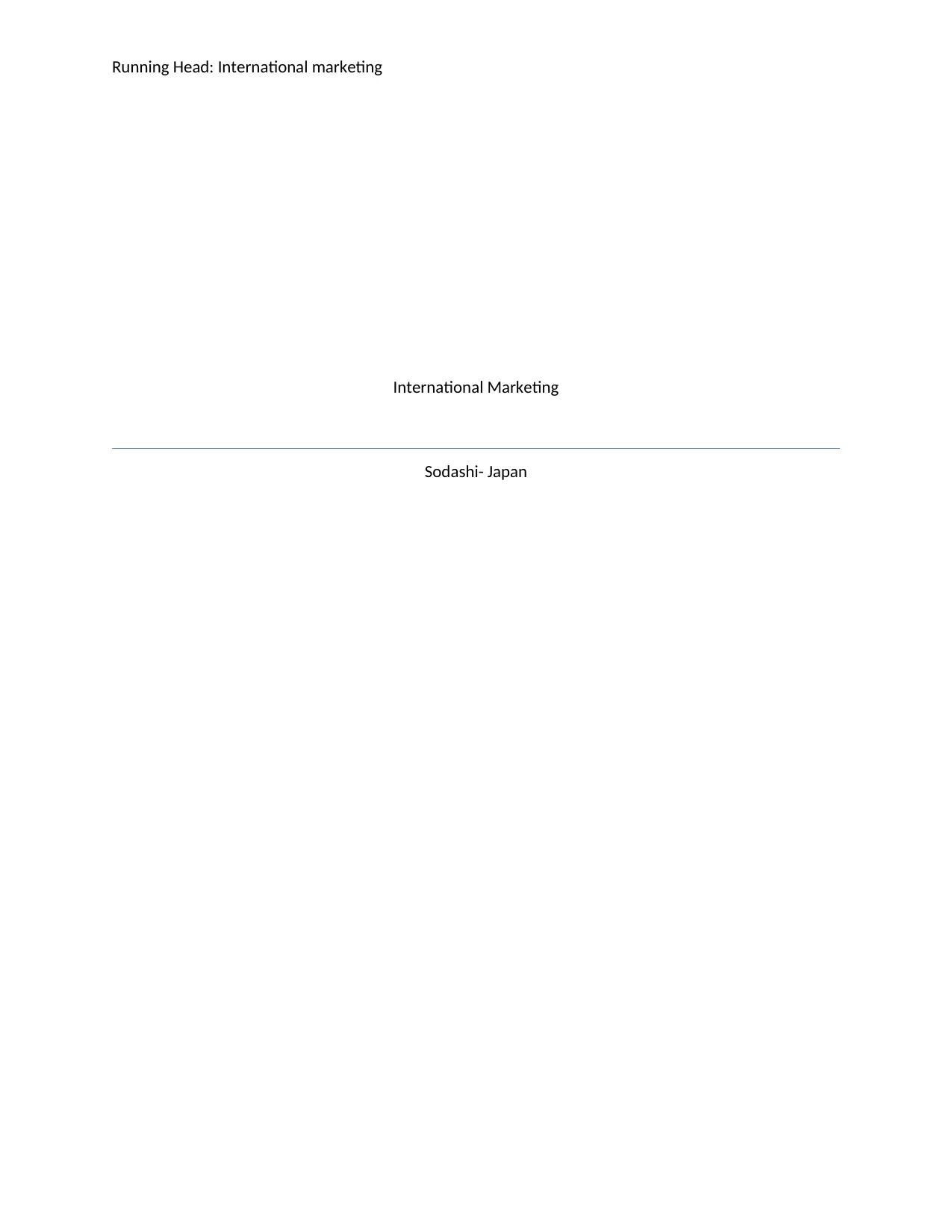
Running Head: International marketing
International Marketing
Sodashi- Japan
International Marketing
Sodashi- Japan
Paraphrase This Document
Need a fresh take? Get an instant paraphrase of this document with our AI Paraphraser
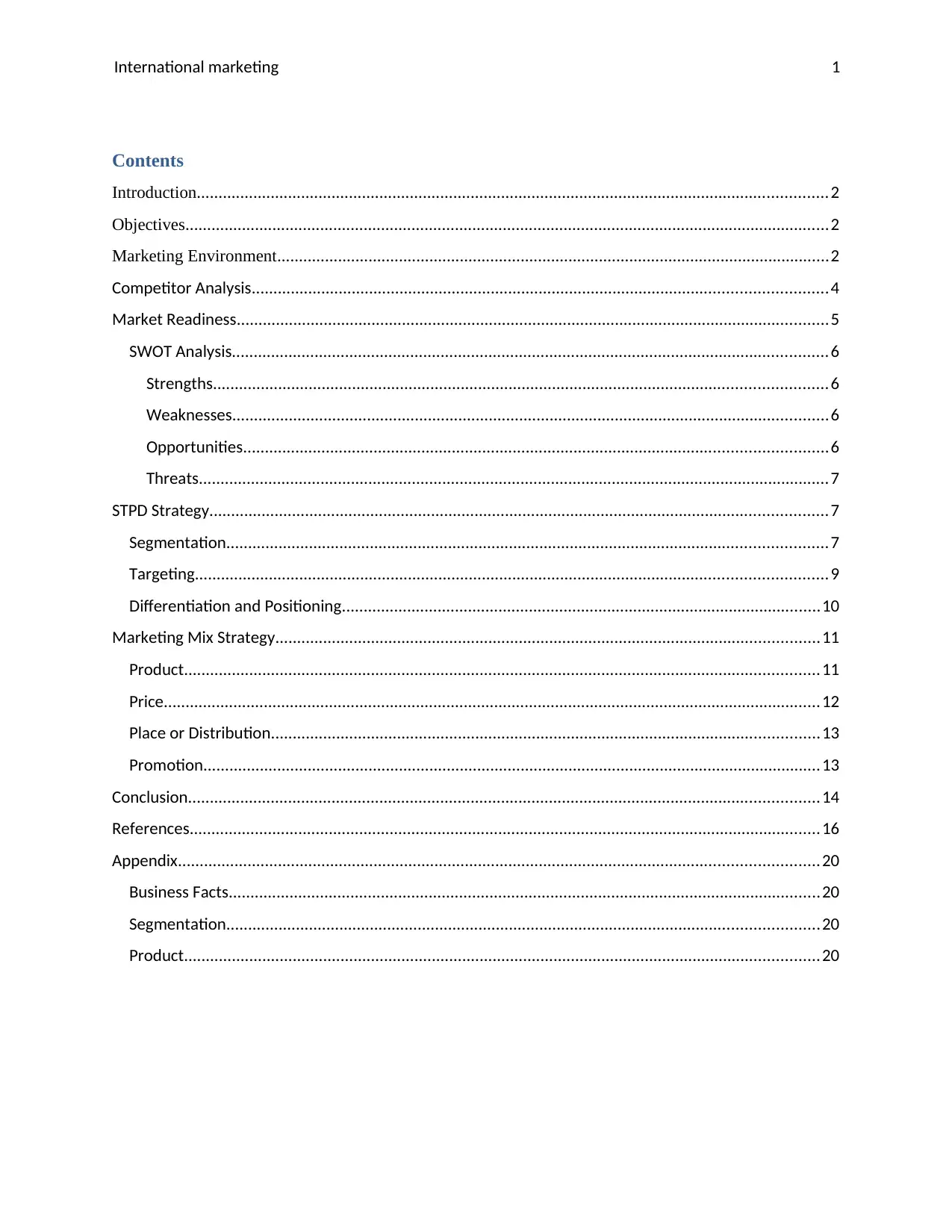
International marketing 1
Contents
Introduction.................................................................................................................................................2
Objectives....................................................................................................................................................2
Marketing Environment...............................................................................................................................2
Competitor Analysis....................................................................................................................................4
Market Readiness........................................................................................................................................5
SWOT Analysis.........................................................................................................................................6
Strengths.............................................................................................................................................6
Weaknesses.........................................................................................................................................6
Opportunities......................................................................................................................................6
Threats.................................................................................................................................................7
STPD Strategy..............................................................................................................................................7
Segmentation..........................................................................................................................................7
Targeting.................................................................................................................................................9
Differentiation and Positioning..............................................................................................................10
Marketing Mix Strategy.............................................................................................................................11
Product..................................................................................................................................................11
Price.......................................................................................................................................................12
Place or Distribution..............................................................................................................................13
Promotion..............................................................................................................................................13
Conclusion.................................................................................................................................................14
References.................................................................................................................................................16
Appendix...................................................................................................................................................20
Business Facts........................................................................................................................................20
Segmentation........................................................................................................................................20
Product..................................................................................................................................................20
Contents
Introduction.................................................................................................................................................2
Objectives....................................................................................................................................................2
Marketing Environment...............................................................................................................................2
Competitor Analysis....................................................................................................................................4
Market Readiness........................................................................................................................................5
SWOT Analysis.........................................................................................................................................6
Strengths.............................................................................................................................................6
Weaknesses.........................................................................................................................................6
Opportunities......................................................................................................................................6
Threats.................................................................................................................................................7
STPD Strategy..............................................................................................................................................7
Segmentation..........................................................................................................................................7
Targeting.................................................................................................................................................9
Differentiation and Positioning..............................................................................................................10
Marketing Mix Strategy.............................................................................................................................11
Product..................................................................................................................................................11
Price.......................................................................................................................................................12
Place or Distribution..............................................................................................................................13
Promotion..............................................................................................................................................13
Conclusion.................................................................................................................................................14
References.................................................................................................................................................16
Appendix...................................................................................................................................................20
Business Facts........................................................................................................................................20
Segmentation........................................................................................................................................20
Product..................................................................................................................................................20
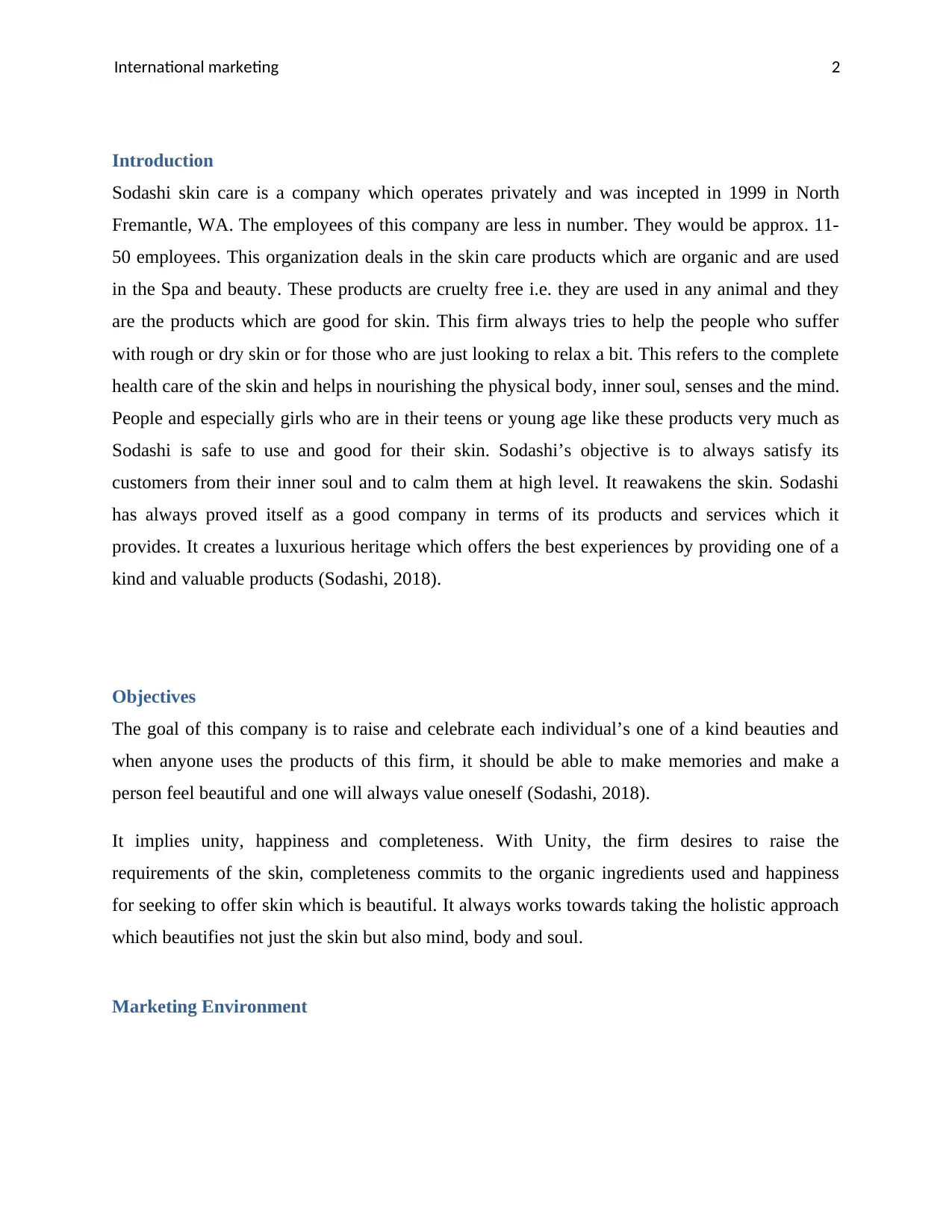
International marketing 2
Introduction
Sodashi skin care is a company which operates privately and was incepted in 1999 in North
Fremantle, WA. The employees of this company are less in number. They would be approx. 11-
50 employees. This organization deals in the skin care products which are organic and are used
in the Spa and beauty. These products are cruelty free i.e. they are used in any animal and they
are the products which are good for skin. This firm always tries to help the people who suffer
with rough or dry skin or for those who are just looking to relax a bit. This refers to the complete
health care of the skin and helps in nourishing the physical body, inner soul, senses and the mind.
People and especially girls who are in their teens or young age like these products very much as
Sodashi is safe to use and good for their skin. Sodashi’s objective is to always satisfy its
customers from their inner soul and to calm them at high level. It reawakens the skin. Sodashi
has always proved itself as a good company in terms of its products and services which it
provides. It creates a luxurious heritage which offers the best experiences by providing one of a
kind and valuable products (Sodashi, 2018).
Objectives
The goal of this company is to raise and celebrate each individual’s one of a kind beauties and
when anyone uses the products of this firm, it should be able to make memories and make a
person feel beautiful and one will always value oneself (Sodashi, 2018).
It implies unity, happiness and completeness. With Unity, the firm desires to raise the
requirements of the skin, completeness commits to the organic ingredients used and happiness
for seeking to offer skin which is beautiful. It always works towards taking the holistic approach
which beautifies not just the skin but also mind, body and soul.
Marketing Environment
Introduction
Sodashi skin care is a company which operates privately and was incepted in 1999 in North
Fremantle, WA. The employees of this company are less in number. They would be approx. 11-
50 employees. This organization deals in the skin care products which are organic and are used
in the Spa and beauty. These products are cruelty free i.e. they are used in any animal and they
are the products which are good for skin. This firm always tries to help the people who suffer
with rough or dry skin or for those who are just looking to relax a bit. This refers to the complete
health care of the skin and helps in nourishing the physical body, inner soul, senses and the mind.
People and especially girls who are in their teens or young age like these products very much as
Sodashi is safe to use and good for their skin. Sodashi’s objective is to always satisfy its
customers from their inner soul and to calm them at high level. It reawakens the skin. Sodashi
has always proved itself as a good company in terms of its products and services which it
provides. It creates a luxurious heritage which offers the best experiences by providing one of a
kind and valuable products (Sodashi, 2018).
Objectives
The goal of this company is to raise and celebrate each individual’s one of a kind beauties and
when anyone uses the products of this firm, it should be able to make memories and make a
person feel beautiful and one will always value oneself (Sodashi, 2018).
It implies unity, happiness and completeness. With Unity, the firm desires to raise the
requirements of the skin, completeness commits to the organic ingredients used and happiness
for seeking to offer skin which is beautiful. It always works towards taking the holistic approach
which beautifies not just the skin but also mind, body and soul.
Marketing Environment
⊘ This is a preview!⊘
Do you want full access?
Subscribe today to unlock all pages.

Trusted by 1+ million students worldwide
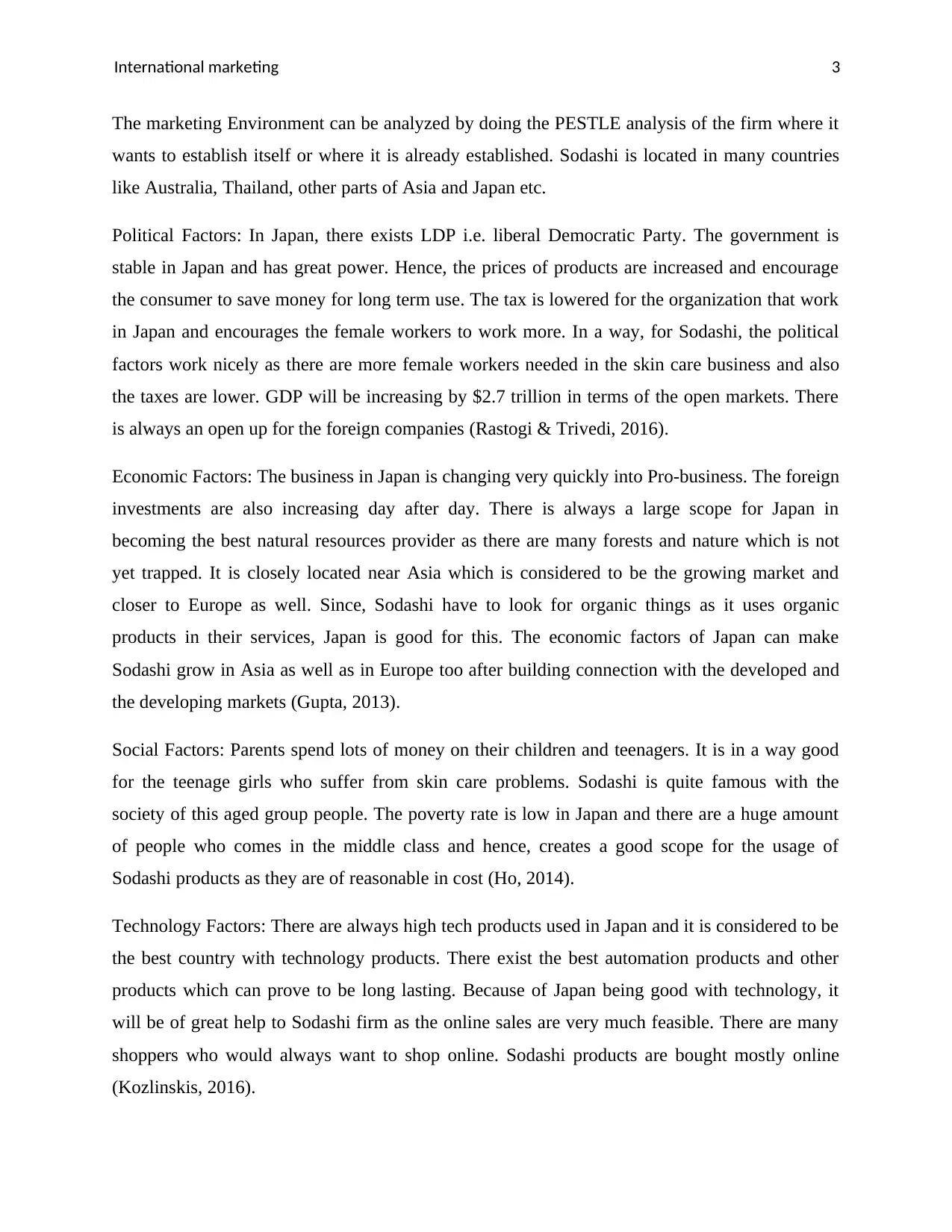
International marketing 3
The marketing Environment can be analyzed by doing the PESTLE analysis of the firm where it
wants to establish itself or where it is already established. Sodashi is located in many countries
like Australia, Thailand, other parts of Asia and Japan etc.
Political Factors: In Japan, there exists LDP i.e. liberal Democratic Party. The government is
stable in Japan and has great power. Hence, the prices of products are increased and encourage
the consumer to save money for long term use. The tax is lowered for the organization that work
in Japan and encourages the female workers to work more. In a way, for Sodashi, the political
factors work nicely as there are more female workers needed in the skin care business and also
the taxes are lower. GDP will be increasing by $2.7 trillion in terms of the open markets. There
is always an open up for the foreign companies (Rastogi & Trivedi, 2016).
Economic Factors: The business in Japan is changing very quickly into Pro-business. The foreign
investments are also increasing day after day. There is always a large scope for Japan in
becoming the best natural resources provider as there are many forests and nature which is not
yet trapped. It is closely located near Asia which is considered to be the growing market and
closer to Europe as well. Since, Sodashi have to look for organic things as it uses organic
products in their services, Japan is good for this. The economic factors of Japan can make
Sodashi grow in Asia as well as in Europe too after building connection with the developed and
the developing markets (Gupta, 2013).
Social Factors: Parents spend lots of money on their children and teenagers. It is in a way good
for the teenage girls who suffer from skin care problems. Sodashi is quite famous with the
society of this aged group people. The poverty rate is low in Japan and there are a huge amount
of people who comes in the middle class and hence, creates a good scope for the usage of
Sodashi products as they are of reasonable in cost (Ho, 2014).
Technology Factors: There are always high tech products used in Japan and it is considered to be
the best country with technology products. There exist the best automation products and other
products which can prove to be long lasting. Because of Japan being good with technology, it
will be of great help to Sodashi firm as the online sales are very much feasible. There are many
shoppers who would always want to shop online. Sodashi products are bought mostly online
(Kozlinskis, 2016).
The marketing Environment can be analyzed by doing the PESTLE analysis of the firm where it
wants to establish itself or where it is already established. Sodashi is located in many countries
like Australia, Thailand, other parts of Asia and Japan etc.
Political Factors: In Japan, there exists LDP i.e. liberal Democratic Party. The government is
stable in Japan and has great power. Hence, the prices of products are increased and encourage
the consumer to save money for long term use. The tax is lowered for the organization that work
in Japan and encourages the female workers to work more. In a way, for Sodashi, the political
factors work nicely as there are more female workers needed in the skin care business and also
the taxes are lower. GDP will be increasing by $2.7 trillion in terms of the open markets. There
is always an open up for the foreign companies (Rastogi & Trivedi, 2016).
Economic Factors: The business in Japan is changing very quickly into Pro-business. The foreign
investments are also increasing day after day. There is always a large scope for Japan in
becoming the best natural resources provider as there are many forests and nature which is not
yet trapped. It is closely located near Asia which is considered to be the growing market and
closer to Europe as well. Since, Sodashi have to look for organic things as it uses organic
products in their services, Japan is good for this. The economic factors of Japan can make
Sodashi grow in Asia as well as in Europe too after building connection with the developed and
the developing markets (Gupta, 2013).
Social Factors: Parents spend lots of money on their children and teenagers. It is in a way good
for the teenage girls who suffer from skin care problems. Sodashi is quite famous with the
society of this aged group people. The poverty rate is low in Japan and there are a huge amount
of people who comes in the middle class and hence, creates a good scope for the usage of
Sodashi products as they are of reasonable in cost (Ho, 2014).
Technology Factors: There are always high tech products used in Japan and it is considered to be
the best country with technology products. There exist the best automation products and other
products which can prove to be long lasting. Because of Japan being good with technology, it
will be of great help to Sodashi firm as the online sales are very much feasible. There are many
shoppers who would always want to shop online. Sodashi products are bought mostly online
(Kozlinskis, 2016).
Paraphrase This Document
Need a fresh take? Get an instant paraphrase of this document with our AI Paraphraser
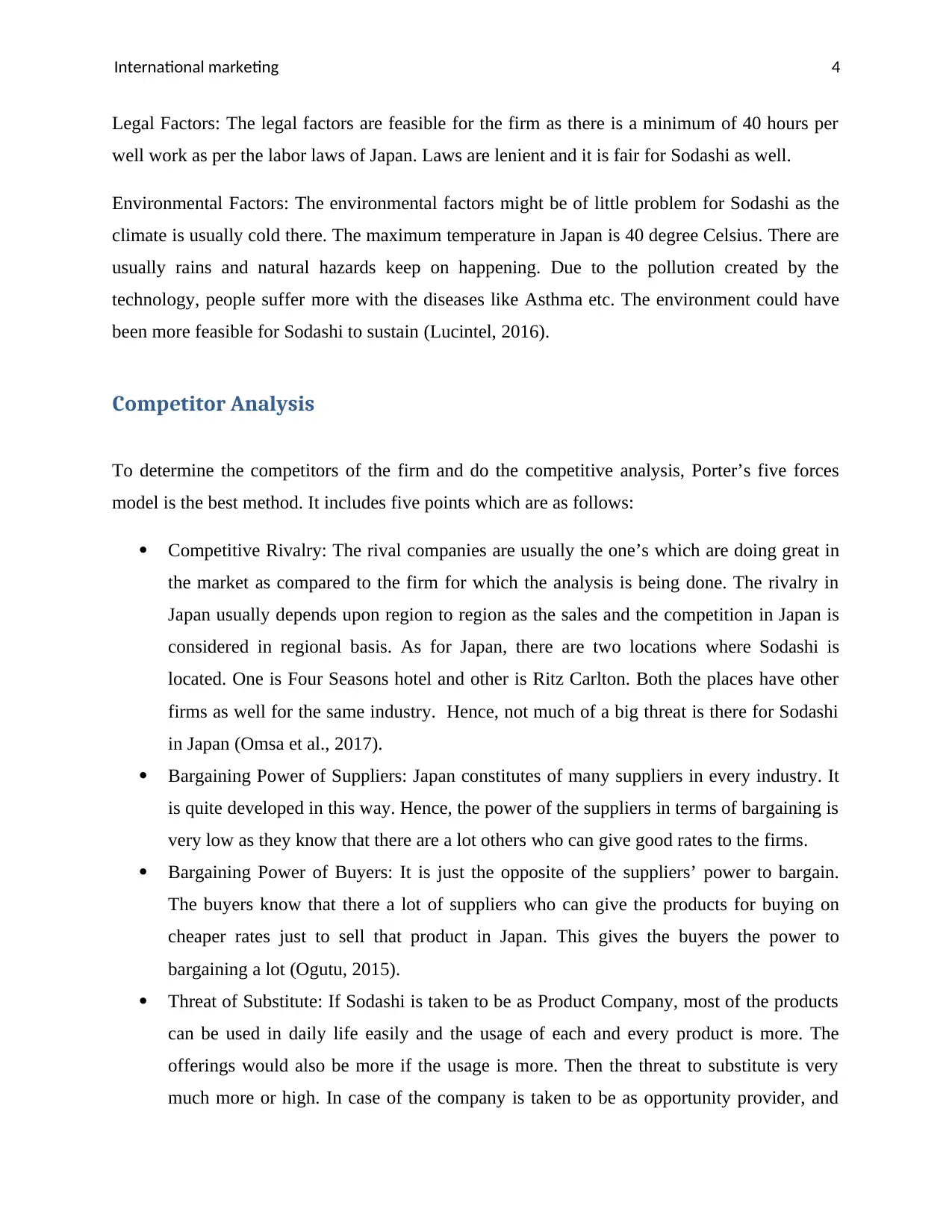
International marketing 4
Legal Factors: The legal factors are feasible for the firm as there is a minimum of 40 hours per
well work as per the labor laws of Japan. Laws are lenient and it is fair for Sodashi as well.
Environmental Factors: The environmental factors might be of little problem for Sodashi as the
climate is usually cold there. The maximum temperature in Japan is 40 degree Celsius. There are
usually rains and natural hazards keep on happening. Due to the pollution created by the
technology, people suffer more with the diseases like Asthma etc. The environment could have
been more feasible for Sodashi to sustain (Lucintel, 2016).
Competitor Analysis
To determine the competitors of the firm and do the competitive analysis, Porter’s five forces
model is the best method. It includes five points which are as follows:
Competitive Rivalry: The rival companies are usually the one’s which are doing great in
the market as compared to the firm for which the analysis is being done. The rivalry in
Japan usually depends upon region to region as the sales and the competition in Japan is
considered in regional basis. As for Japan, there are two locations where Sodashi is
located. One is Four Seasons hotel and other is Ritz Carlton. Both the places have other
firms as well for the same industry. Hence, not much of a big threat is there for Sodashi
in Japan (Omsa et al., 2017).
Bargaining Power of Suppliers: Japan constitutes of many suppliers in every industry. It
is quite developed in this way. Hence, the power of the suppliers in terms of bargaining is
very low as they know that there are a lot others who can give good rates to the firms.
Bargaining Power of Buyers: It is just the opposite of the suppliers’ power to bargain.
The buyers know that there a lot of suppliers who can give the products for buying on
cheaper rates just to sell that product in Japan. This gives the buyers the power to
bargaining a lot (Ogutu, 2015).
Threat of Substitute: If Sodashi is taken to be as Product Company, most of the products
can be used in daily life easily and the usage of each and every product is more. The
offerings would also be more if the usage is more. Then the threat to substitute is very
much more or high. In case of the company is taken to be as opportunity provider, and
Legal Factors: The legal factors are feasible for the firm as there is a minimum of 40 hours per
well work as per the labor laws of Japan. Laws are lenient and it is fair for Sodashi as well.
Environmental Factors: The environmental factors might be of little problem for Sodashi as the
climate is usually cold there. The maximum temperature in Japan is 40 degree Celsius. There are
usually rains and natural hazards keep on happening. Due to the pollution created by the
technology, people suffer more with the diseases like Asthma etc. The environment could have
been more feasible for Sodashi to sustain (Lucintel, 2016).
Competitor Analysis
To determine the competitors of the firm and do the competitive analysis, Porter’s five forces
model is the best method. It includes five points which are as follows:
Competitive Rivalry: The rival companies are usually the one’s which are doing great in
the market as compared to the firm for which the analysis is being done. The rivalry in
Japan usually depends upon region to region as the sales and the competition in Japan is
considered in regional basis. As for Japan, there are two locations where Sodashi is
located. One is Four Seasons hotel and other is Ritz Carlton. Both the places have other
firms as well for the same industry. Hence, not much of a big threat is there for Sodashi
in Japan (Omsa et al., 2017).
Bargaining Power of Suppliers: Japan constitutes of many suppliers in every industry. It
is quite developed in this way. Hence, the power of the suppliers in terms of bargaining is
very low as they know that there are a lot others who can give good rates to the firms.
Bargaining Power of Buyers: It is just the opposite of the suppliers’ power to bargain.
The buyers know that there a lot of suppliers who can give the products for buying on
cheaper rates just to sell that product in Japan. This gives the buyers the power to
bargaining a lot (Ogutu, 2015).
Threat of Substitute: If Sodashi is taken to be as Product Company, most of the products
can be used in daily life easily and the usage of each and every product is more. The
offerings would also be more if the usage is more. Then the threat to substitute is very
much more or high. In case of the company is taken to be as opportunity provider, and
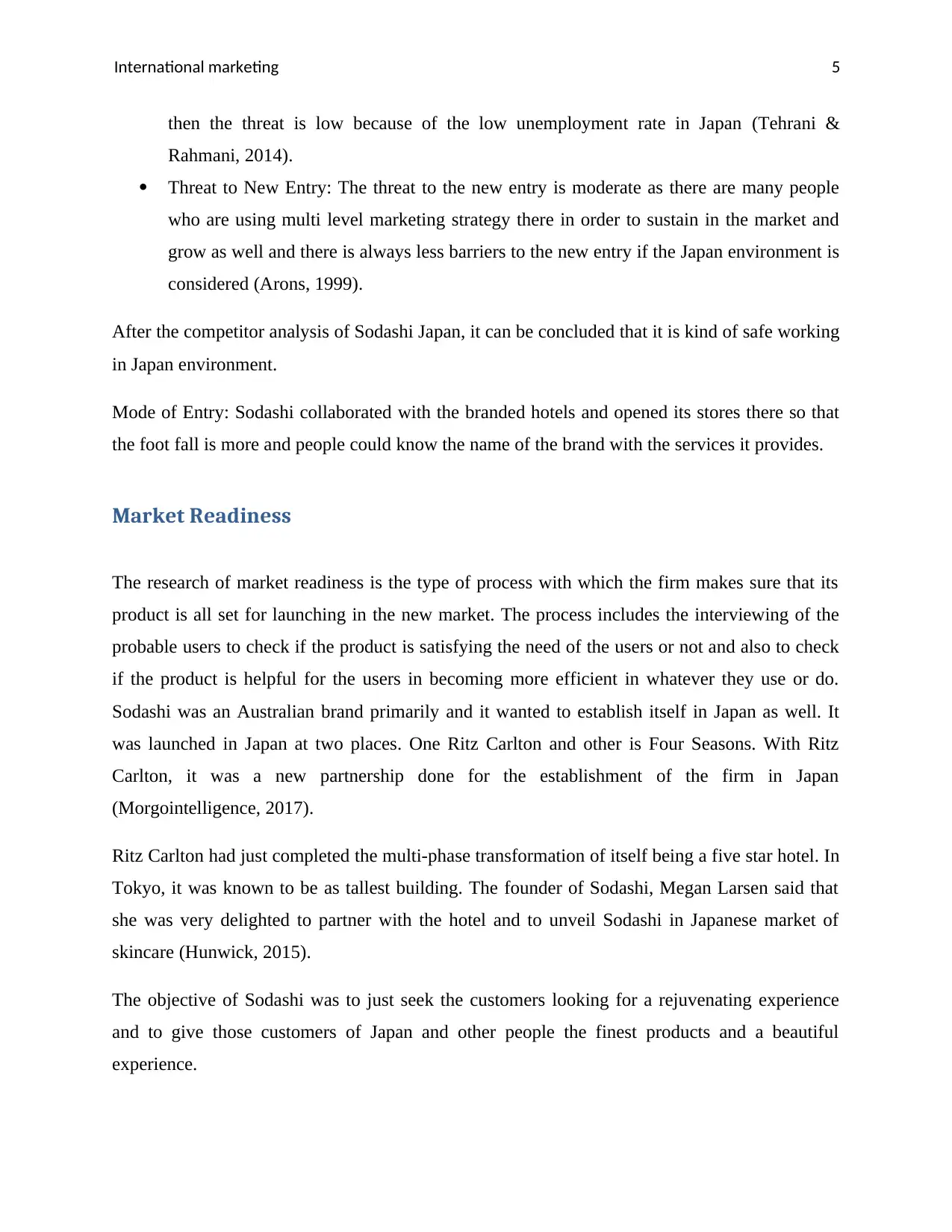
International marketing 5
then the threat is low because of the low unemployment rate in Japan (Tehrani &
Rahmani, 2014).
Threat to New Entry: The threat to the new entry is moderate as there are many people
who are using multi level marketing strategy there in order to sustain in the market and
grow as well and there is always less barriers to the new entry if the Japan environment is
considered (Arons, 1999).
After the competitor analysis of Sodashi Japan, it can be concluded that it is kind of safe working
in Japan environment.
Mode of Entry: Sodashi collaborated with the branded hotels and opened its stores there so that
the foot fall is more and people could know the name of the brand with the services it provides.
Market Readiness
The research of market readiness is the type of process with which the firm makes sure that its
product is all set for launching in the new market. The process includes the interviewing of the
probable users to check if the product is satisfying the need of the users or not and also to check
if the product is helpful for the users in becoming more efficient in whatever they use or do.
Sodashi was an Australian brand primarily and it wanted to establish itself in Japan as well. It
was launched in Japan at two places. One Ritz Carlton and other is Four Seasons. With Ritz
Carlton, it was a new partnership done for the establishment of the firm in Japan
(Morgointelligence, 2017).
Ritz Carlton had just completed the multi-phase transformation of itself being a five star hotel. In
Tokyo, it was known to be as tallest building. The founder of Sodashi, Megan Larsen said that
she was very delighted to partner with the hotel and to unveil Sodashi in Japanese market of
skincare (Hunwick, 2015).
The objective of Sodashi was to just seek the customers looking for a rejuvenating experience
and to give those customers of Japan and other people the finest products and a beautiful
experience.
then the threat is low because of the low unemployment rate in Japan (Tehrani &
Rahmani, 2014).
Threat to New Entry: The threat to the new entry is moderate as there are many people
who are using multi level marketing strategy there in order to sustain in the market and
grow as well and there is always less barriers to the new entry if the Japan environment is
considered (Arons, 1999).
After the competitor analysis of Sodashi Japan, it can be concluded that it is kind of safe working
in Japan environment.
Mode of Entry: Sodashi collaborated with the branded hotels and opened its stores there so that
the foot fall is more and people could know the name of the brand with the services it provides.
Market Readiness
The research of market readiness is the type of process with which the firm makes sure that its
product is all set for launching in the new market. The process includes the interviewing of the
probable users to check if the product is satisfying the need of the users or not and also to check
if the product is helpful for the users in becoming more efficient in whatever they use or do.
Sodashi was an Australian brand primarily and it wanted to establish itself in Japan as well. It
was launched in Japan at two places. One Ritz Carlton and other is Four Seasons. With Ritz
Carlton, it was a new partnership done for the establishment of the firm in Japan
(Morgointelligence, 2017).
Ritz Carlton had just completed the multi-phase transformation of itself being a five star hotel. In
Tokyo, it was known to be as tallest building. The founder of Sodashi, Megan Larsen said that
she was very delighted to partner with the hotel and to unveil Sodashi in Japanese market of
skincare (Hunwick, 2015).
The objective of Sodashi was to just seek the customers looking for a rejuvenating experience
and to give those customers of Japan and other people the finest products and a beautiful
experience.
⊘ This is a preview!⊘
Do you want full access?
Subscribe today to unlock all pages.

Trusted by 1+ million students worldwide
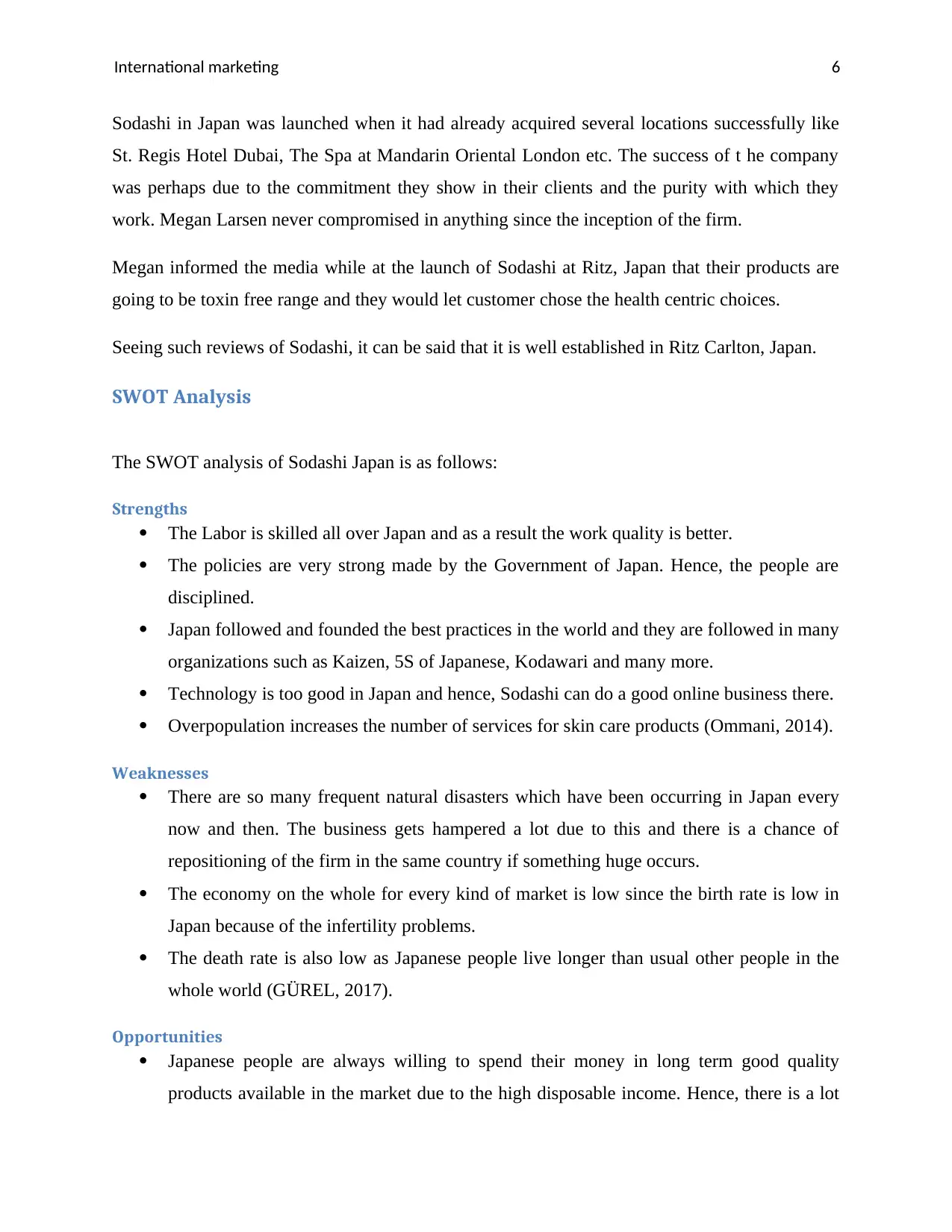
International marketing 6
Sodashi in Japan was launched when it had already acquired several locations successfully like
St. Regis Hotel Dubai, The Spa at Mandarin Oriental London etc. The success of t he company
was perhaps due to the commitment they show in their clients and the purity with which they
work. Megan Larsen never compromised in anything since the inception of the firm.
Megan informed the media while at the launch of Sodashi at Ritz, Japan that their products are
going to be toxin free range and they would let customer chose the health centric choices.
Seeing such reviews of Sodashi, it can be said that it is well established in Ritz Carlton, Japan.
SWOT Analysis
The SWOT analysis of Sodashi Japan is as follows:
Strengths
The Labor is skilled all over Japan and as a result the work quality is better.
The policies are very strong made by the Government of Japan. Hence, the people are
disciplined.
Japan followed and founded the best practices in the world and they are followed in many
organizations such as Kaizen, 5S of Japanese, Kodawari and many more.
Technology is too good in Japan and hence, Sodashi can do a good online business there.
Overpopulation increases the number of services for skin care products (Ommani, 2014).
Weaknesses
There are so many frequent natural disasters which have been occurring in Japan every
now and then. The business gets hampered a lot due to this and there is a chance of
repositioning of the firm in the same country if something huge occurs.
The economy on the whole for every kind of market is low since the birth rate is low in
Japan because of the infertility problems.
The death rate is also low as Japanese people live longer than usual other people in the
whole world (GÜREL, 2017).
Opportunities
Japanese people are always willing to spend their money in long term good quality
products available in the market due to the high disposable income. Hence, there is a lot
Sodashi in Japan was launched when it had already acquired several locations successfully like
St. Regis Hotel Dubai, The Spa at Mandarin Oriental London etc. The success of t he company
was perhaps due to the commitment they show in their clients and the purity with which they
work. Megan Larsen never compromised in anything since the inception of the firm.
Megan informed the media while at the launch of Sodashi at Ritz, Japan that their products are
going to be toxin free range and they would let customer chose the health centric choices.
Seeing such reviews of Sodashi, it can be said that it is well established in Ritz Carlton, Japan.
SWOT Analysis
The SWOT analysis of Sodashi Japan is as follows:
Strengths
The Labor is skilled all over Japan and as a result the work quality is better.
The policies are very strong made by the Government of Japan. Hence, the people are
disciplined.
Japan followed and founded the best practices in the world and they are followed in many
organizations such as Kaizen, 5S of Japanese, Kodawari and many more.
Technology is too good in Japan and hence, Sodashi can do a good online business there.
Overpopulation increases the number of services for skin care products (Ommani, 2014).
Weaknesses
There are so many frequent natural disasters which have been occurring in Japan every
now and then. The business gets hampered a lot due to this and there is a chance of
repositioning of the firm in the same country if something huge occurs.
The economy on the whole for every kind of market is low since the birth rate is low in
Japan because of the infertility problems.
The death rate is also low as Japanese people live longer than usual other people in the
whole world (GÜREL, 2017).
Opportunities
Japanese people are always willing to spend their money in long term good quality
products available in the market due to the high disposable income. Hence, there is a lot
Paraphrase This Document
Need a fresh take? Get an instant paraphrase of this document with our AI Paraphraser
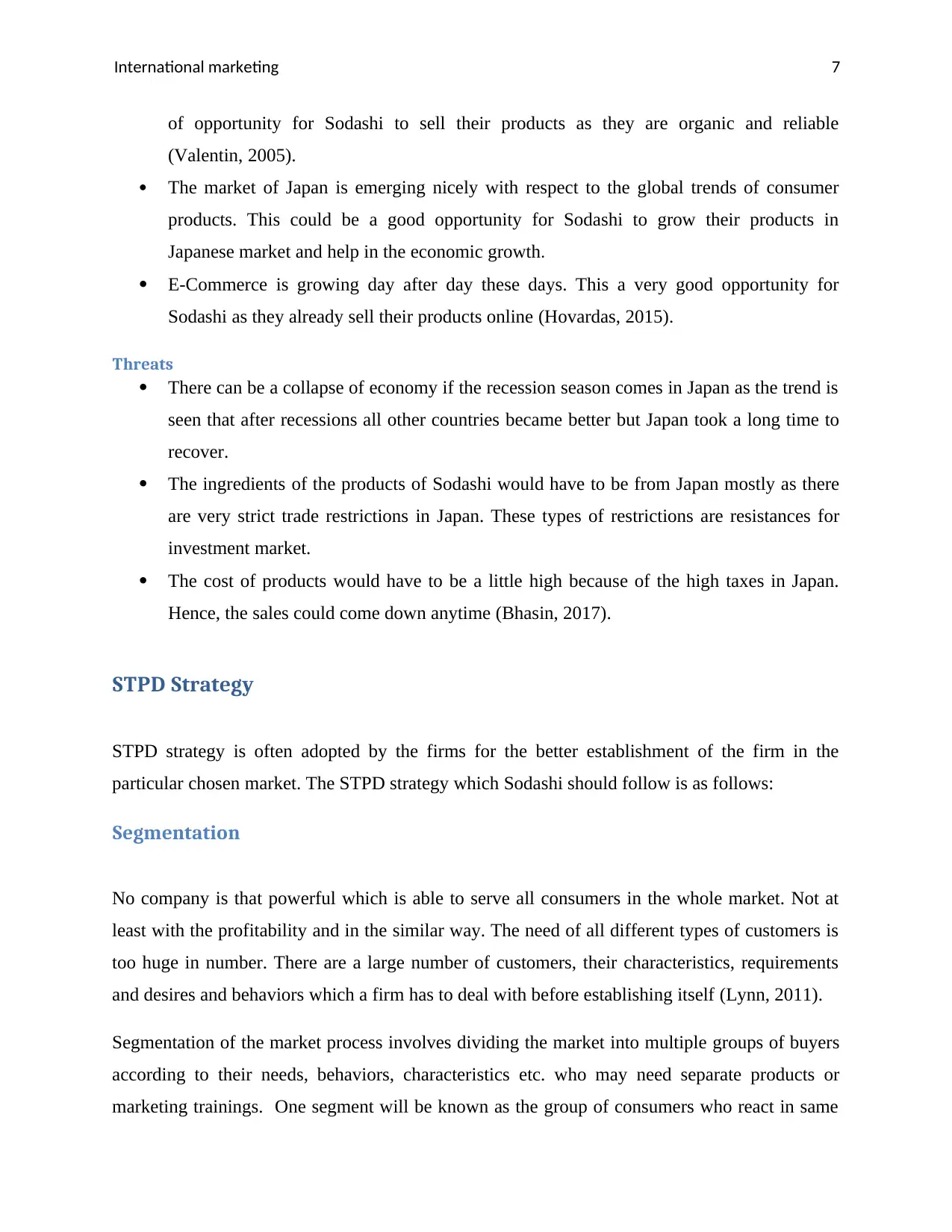
International marketing 7
of opportunity for Sodashi to sell their products as they are organic and reliable
(Valentin, 2005).
The market of Japan is emerging nicely with respect to the global trends of consumer
products. This could be a good opportunity for Sodashi to grow their products in
Japanese market and help in the economic growth.
E-Commerce is growing day after day these days. This a very good opportunity for
Sodashi as they already sell their products online (Hovardas, 2015).
Threats
There can be a collapse of economy if the recession season comes in Japan as the trend is
seen that after recessions all other countries became better but Japan took a long time to
recover.
The ingredients of the products of Sodashi would have to be from Japan mostly as there
are very strict trade restrictions in Japan. These types of restrictions are resistances for
investment market.
The cost of products would have to be a little high because of the high taxes in Japan.
Hence, the sales could come down anytime (Bhasin, 2017).
STPD Strategy
STPD strategy is often adopted by the firms for the better establishment of the firm in the
particular chosen market. The STPD strategy which Sodashi should follow is as follows:
Segmentation
No company is that powerful which is able to serve all consumers in the whole market. Not at
least with the profitability and in the similar way. The need of all different types of customers is
too huge in number. There are a large number of customers, their characteristics, requirements
and desires and behaviors which a firm has to deal with before establishing itself (Lynn, 2011).
Segmentation of the market process involves dividing the market into multiple groups of buyers
according to their needs, behaviors, characteristics etc. who may need separate products or
marketing trainings. One segment will be known as the group of consumers who react in same
of opportunity for Sodashi to sell their products as they are organic and reliable
(Valentin, 2005).
The market of Japan is emerging nicely with respect to the global trends of consumer
products. This could be a good opportunity for Sodashi to grow their products in
Japanese market and help in the economic growth.
E-Commerce is growing day after day these days. This a very good opportunity for
Sodashi as they already sell their products online (Hovardas, 2015).
Threats
There can be a collapse of economy if the recession season comes in Japan as the trend is
seen that after recessions all other countries became better but Japan took a long time to
recover.
The ingredients of the products of Sodashi would have to be from Japan mostly as there
are very strict trade restrictions in Japan. These types of restrictions are resistances for
investment market.
The cost of products would have to be a little high because of the high taxes in Japan.
Hence, the sales could come down anytime (Bhasin, 2017).
STPD Strategy
STPD strategy is often adopted by the firms for the better establishment of the firm in the
particular chosen market. The STPD strategy which Sodashi should follow is as follows:
Segmentation
No company is that powerful which is able to serve all consumers in the whole market. Not at
least with the profitability and in the similar way. The need of all different types of customers is
too huge in number. There are a large number of customers, their characteristics, requirements
and desires and behaviors which a firm has to deal with before establishing itself (Lynn, 2011).
Segmentation of the market process involves dividing the market into multiple groups of buyers
according to their needs, behaviors, characteristics etc. who may need separate products or
marketing trainings. One segment will be known as the group of consumers who react in same
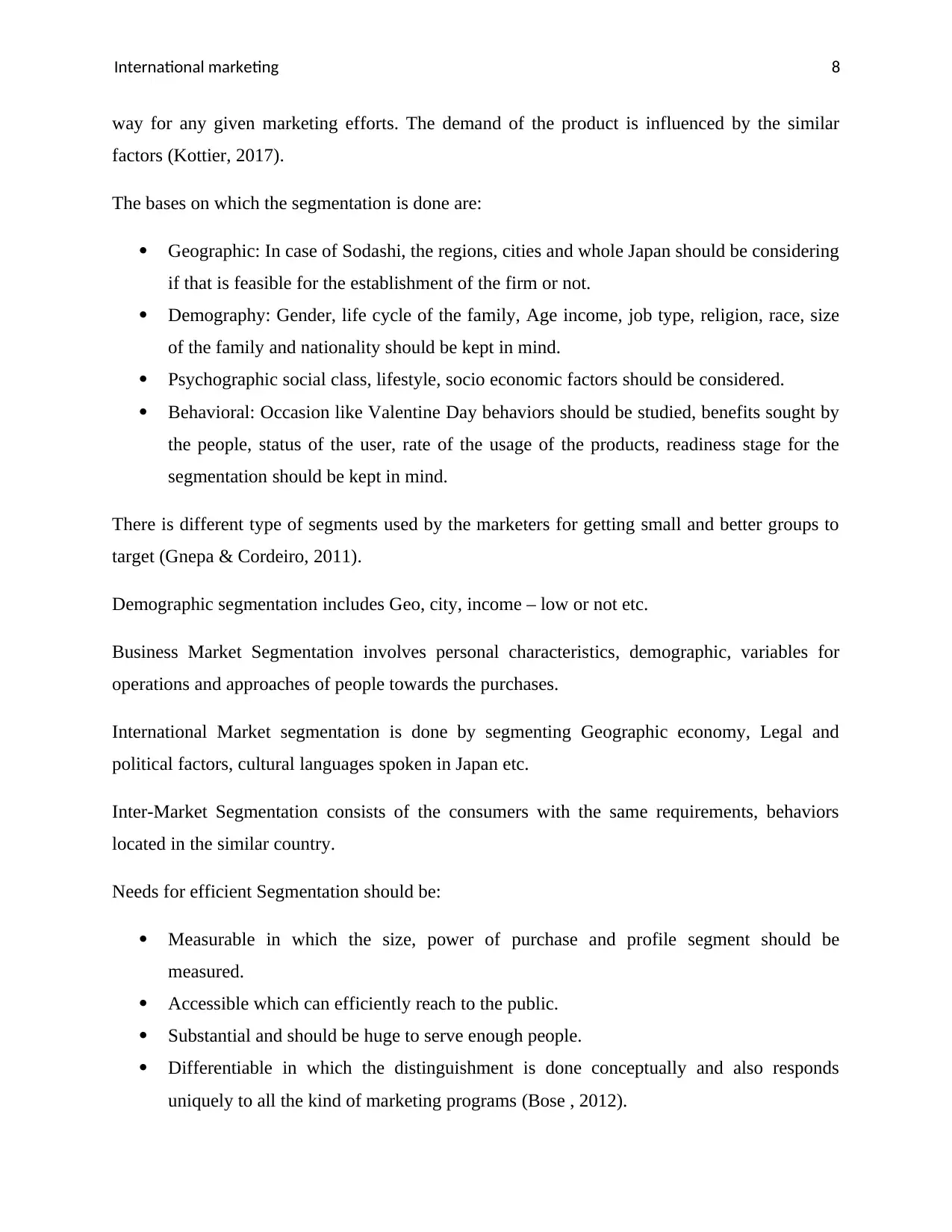
International marketing 8
way for any given marketing efforts. The demand of the product is influenced by the similar
factors (Kottier, 2017).
The bases on which the segmentation is done are:
Geographic: In case of Sodashi, the regions, cities and whole Japan should be considering
if that is feasible for the establishment of the firm or not.
Demography: Gender, life cycle of the family, Age income, job type, religion, race, size
of the family and nationality should be kept in mind.
Psychographic social class, lifestyle, socio economic factors should be considered.
Behavioral: Occasion like Valentine Day behaviors should be studied, benefits sought by
the people, status of the user, rate of the usage of the products, readiness stage for the
segmentation should be kept in mind.
There is different type of segments used by the marketers for getting small and better groups to
target (Gnepa & Cordeiro, 2011).
Demographic segmentation includes Geo, city, income – low or not etc.
Business Market Segmentation involves personal characteristics, demographic, variables for
operations and approaches of people towards the purchases.
International Market segmentation is done by segmenting Geographic economy, Legal and
political factors, cultural languages spoken in Japan etc.
Inter-Market Segmentation consists of the consumers with the same requirements, behaviors
located in the similar country.
Needs for efficient Segmentation should be:
Measurable in which the size, power of purchase and profile segment should be
measured.
Accessible which can efficiently reach to the public.
Substantial and should be huge to serve enough people.
Differentiable in which the distinguishment is done conceptually and also responds
uniquely to all the kind of marketing programs (Bose , 2012).
way for any given marketing efforts. The demand of the product is influenced by the similar
factors (Kottier, 2017).
The bases on which the segmentation is done are:
Geographic: In case of Sodashi, the regions, cities and whole Japan should be considering
if that is feasible for the establishment of the firm or not.
Demography: Gender, life cycle of the family, Age income, job type, religion, race, size
of the family and nationality should be kept in mind.
Psychographic social class, lifestyle, socio economic factors should be considered.
Behavioral: Occasion like Valentine Day behaviors should be studied, benefits sought by
the people, status of the user, rate of the usage of the products, readiness stage for the
segmentation should be kept in mind.
There is different type of segments used by the marketers for getting small and better groups to
target (Gnepa & Cordeiro, 2011).
Demographic segmentation includes Geo, city, income – low or not etc.
Business Market Segmentation involves personal characteristics, demographic, variables for
operations and approaches of people towards the purchases.
International Market segmentation is done by segmenting Geographic economy, Legal and
political factors, cultural languages spoken in Japan etc.
Inter-Market Segmentation consists of the consumers with the same requirements, behaviors
located in the similar country.
Needs for efficient Segmentation should be:
Measurable in which the size, power of purchase and profile segment should be
measured.
Accessible which can efficiently reach to the public.
Substantial and should be huge to serve enough people.
Differentiable in which the distinguishment is done conceptually and also responds
uniquely to all the kind of marketing programs (Bose , 2012).
⊘ This is a preview!⊘
Do you want full access?
Subscribe today to unlock all pages.

Trusted by 1+ million students worldwide
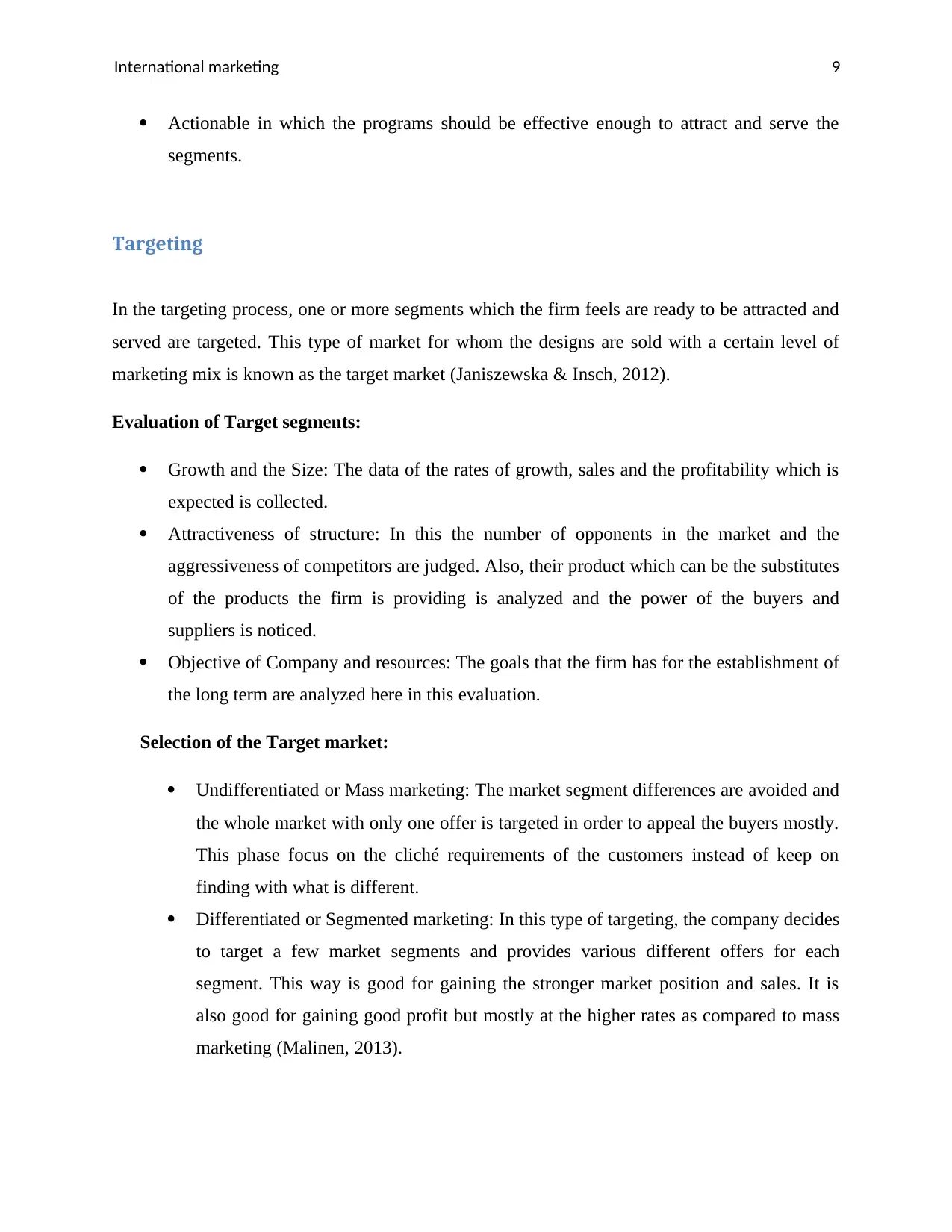
International marketing 9
Actionable in which the programs should be effective enough to attract and serve the
segments.
Targeting
In the targeting process, one or more segments which the firm feels are ready to be attracted and
served are targeted. This type of market for whom the designs are sold with a certain level of
marketing mix is known as the target market (Janiszewska & Insch, 2012).
Evaluation of Target segments:
Growth and the Size: The data of the rates of growth, sales and the profitability which is
expected is collected.
Attractiveness of structure: In this the number of opponents in the market and the
aggressiveness of competitors are judged. Also, their product which can be the substitutes
of the products the firm is providing is analyzed and the power of the buyers and
suppliers is noticed.
Objective of Company and resources: The goals that the firm has for the establishment of
the long term are analyzed here in this evaluation.
Selection of the Target market:
Undifferentiated or Mass marketing: The market segment differences are avoided and
the whole market with only one offer is targeted in order to appeal the buyers mostly.
This phase focus on the cliché requirements of the customers instead of keep on
finding with what is different.
Differentiated or Segmented marketing: In this type of targeting, the company decides
to target a few market segments and provides various different offers for each
segment. This way is good for gaining the stronger market position and sales. It is
also good for gaining good profit but mostly at the higher rates as compared to mass
marketing (Malinen, 2013).
Actionable in which the programs should be effective enough to attract and serve the
segments.
Targeting
In the targeting process, one or more segments which the firm feels are ready to be attracted and
served are targeted. This type of market for whom the designs are sold with a certain level of
marketing mix is known as the target market (Janiszewska & Insch, 2012).
Evaluation of Target segments:
Growth and the Size: The data of the rates of growth, sales and the profitability which is
expected is collected.
Attractiveness of structure: In this the number of opponents in the market and the
aggressiveness of competitors are judged. Also, their product which can be the substitutes
of the products the firm is providing is analyzed and the power of the buyers and
suppliers is noticed.
Objective of Company and resources: The goals that the firm has for the establishment of
the long term are analyzed here in this evaluation.
Selection of the Target market:
Undifferentiated or Mass marketing: The market segment differences are avoided and
the whole market with only one offer is targeted in order to appeal the buyers mostly.
This phase focus on the cliché requirements of the customers instead of keep on
finding with what is different.
Differentiated or Segmented marketing: In this type of targeting, the company decides
to target a few market segments and provides various different offers for each
segment. This way is good for gaining the stronger market position and sales. It is
also good for gaining good profit but mostly at the higher rates as compared to mass
marketing (Malinen, 2013).
Paraphrase This Document
Need a fresh take? Get an instant paraphrase of this document with our AI Paraphraser
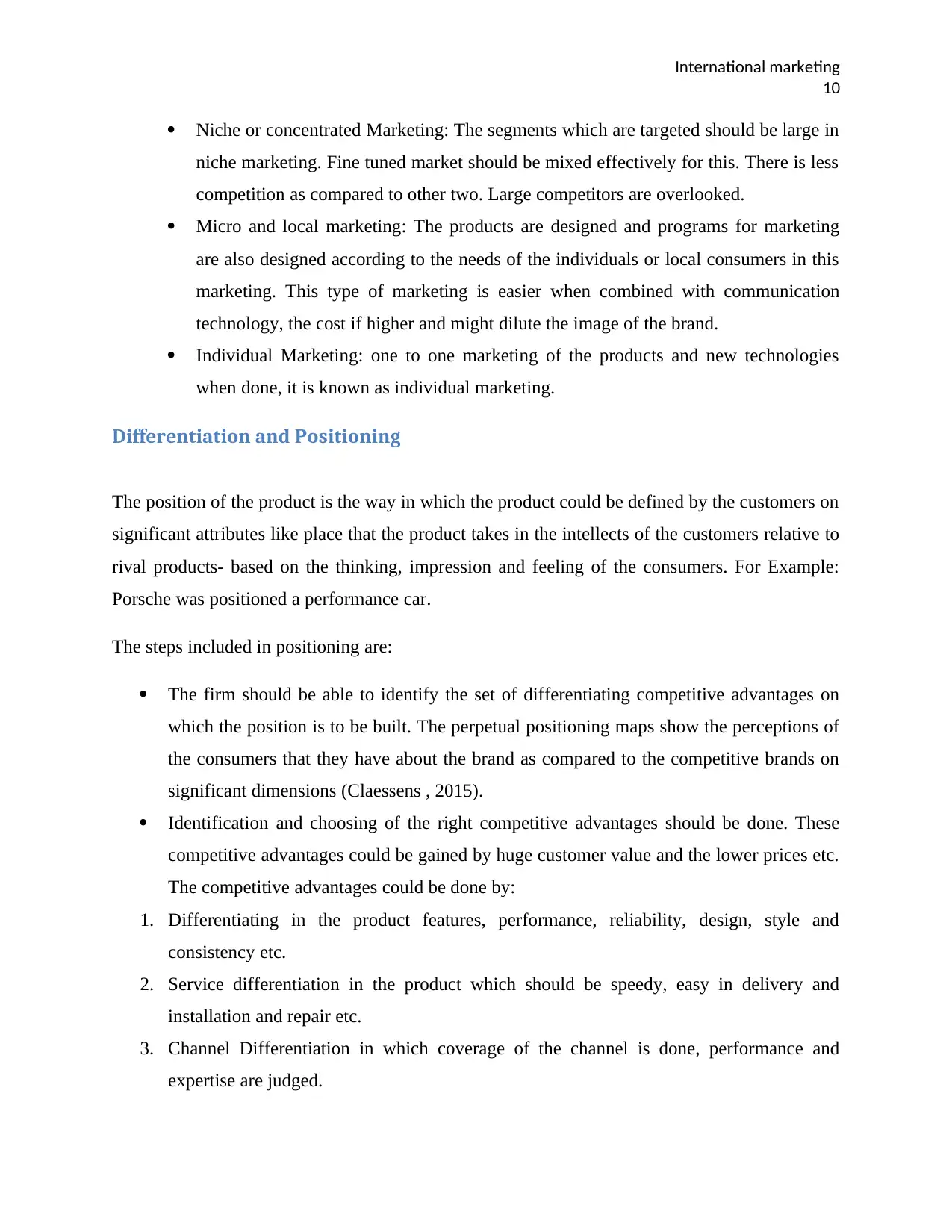
International marketing
10
Niche or concentrated Marketing: The segments which are targeted should be large in
niche marketing. Fine tuned market should be mixed effectively for this. There is less
competition as compared to other two. Large competitors are overlooked.
Micro and local marketing: The products are designed and programs for marketing
are also designed according to the needs of the individuals or local consumers in this
marketing. This type of marketing is easier when combined with communication
technology, the cost if higher and might dilute the image of the brand.
Individual Marketing: one to one marketing of the products and new technologies
when done, it is known as individual marketing.
Differentiation and Positioning
The position of the product is the way in which the product could be defined by the customers on
significant attributes like place that the product takes in the intellects of the customers relative to
rival products- based on the thinking, impression and feeling of the consumers. For Example:
Porsche was positioned a performance car.
The steps included in positioning are:
The firm should be able to identify the set of differentiating competitive advantages on
which the position is to be built. The perpetual positioning maps show the perceptions of
the consumers that they have about the brand as compared to the competitive brands on
significant dimensions (Claessens , 2015).
Identification and choosing of the right competitive advantages should be done. These
competitive advantages could be gained by huge customer value and the lower prices etc.
The competitive advantages could be done by:
1. Differentiating in the product features, performance, reliability, design, style and
consistency etc.
2. Service differentiation in the product which should be speedy, easy in delivery and
installation and repair etc.
3. Channel Differentiation in which coverage of the channel is done, performance and
expertise are judged.
10
Niche or concentrated Marketing: The segments which are targeted should be large in
niche marketing. Fine tuned market should be mixed effectively for this. There is less
competition as compared to other two. Large competitors are overlooked.
Micro and local marketing: The products are designed and programs for marketing
are also designed according to the needs of the individuals or local consumers in this
marketing. This type of marketing is easier when combined with communication
technology, the cost if higher and might dilute the image of the brand.
Individual Marketing: one to one marketing of the products and new technologies
when done, it is known as individual marketing.
Differentiation and Positioning
The position of the product is the way in which the product could be defined by the customers on
significant attributes like place that the product takes in the intellects of the customers relative to
rival products- based on the thinking, impression and feeling of the consumers. For Example:
Porsche was positioned a performance car.
The steps included in positioning are:
The firm should be able to identify the set of differentiating competitive advantages on
which the position is to be built. The perpetual positioning maps show the perceptions of
the consumers that they have about the brand as compared to the competitive brands on
significant dimensions (Claessens , 2015).
Identification and choosing of the right competitive advantages should be done. These
competitive advantages could be gained by huge customer value and the lower prices etc.
The competitive advantages could be done by:
1. Differentiating in the product features, performance, reliability, design, style and
consistency etc.
2. Service differentiation in the product which should be speedy, easy in delivery and
installation and repair etc.
3. Channel Differentiation in which coverage of the channel is done, performance and
expertise are judged.
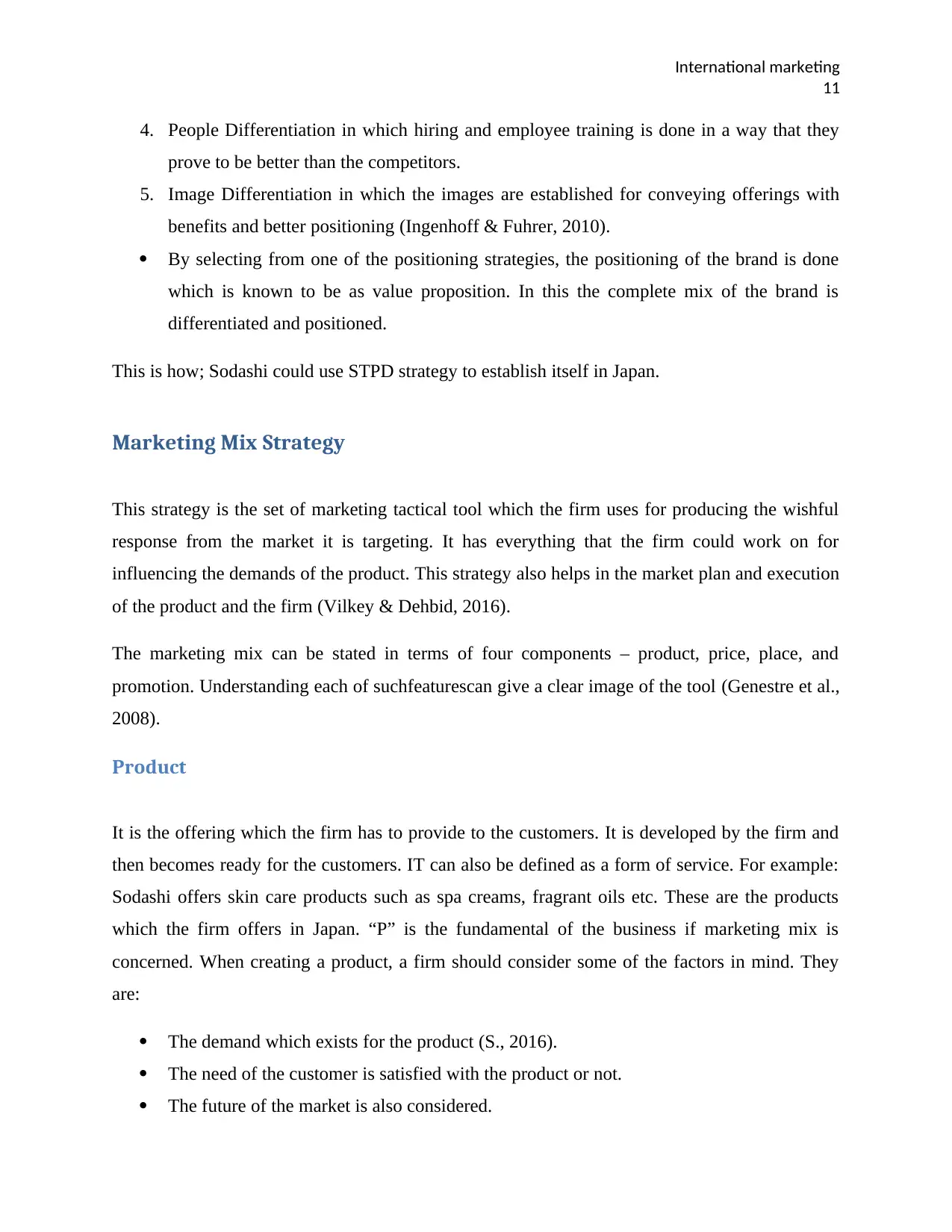
International marketing
11
4. People Differentiation in which hiring and employee training is done in a way that they
prove to be better than the competitors.
5. Image Differentiation in which the images are established for conveying offerings with
benefits and better positioning (Ingenhoff & Fuhrer, 2010).
By selecting from one of the positioning strategies, the positioning of the brand is done
which is known to be as value proposition. In this the complete mix of the brand is
differentiated and positioned.
This is how; Sodashi could use STPD strategy to establish itself in Japan.
Marketing Mix Strategy
This strategy is the set of marketing tactical tool which the firm uses for producing the wishful
response from the market it is targeting. It has everything that the firm could work on for
influencing the demands of the product. This strategy also helps in the market plan and execution
of the product and the firm (Vilkey & Dehbid, 2016).
The marketing mix can be stated in terms of four components – product, price, place, and
promotion. Understanding each of suchfeaturescan give a clear image of the tool (Genestre et al.,
2008).
Product
It is the offering which the firm has to provide to the customers. It is developed by the firm and
then becomes ready for the customers. IT can also be defined as a form of service. For example:
Sodashi offers skin care products such as spa creams, fragrant oils etc. These are the products
which the firm offers in Japan. “P” is the fundamental of the business if marketing mix is
concerned. When creating a product, a firm should consider some of the factors in mind. They
are:
The demand which exists for the product (S., 2016).
The need of the customer is satisfied with the product or not.
The future of the market is also considered.
11
4. People Differentiation in which hiring and employee training is done in a way that they
prove to be better than the competitors.
5. Image Differentiation in which the images are established for conveying offerings with
benefits and better positioning (Ingenhoff & Fuhrer, 2010).
By selecting from one of the positioning strategies, the positioning of the brand is done
which is known to be as value proposition. In this the complete mix of the brand is
differentiated and positioned.
This is how; Sodashi could use STPD strategy to establish itself in Japan.
Marketing Mix Strategy
This strategy is the set of marketing tactical tool which the firm uses for producing the wishful
response from the market it is targeting. It has everything that the firm could work on for
influencing the demands of the product. This strategy also helps in the market plan and execution
of the product and the firm (Vilkey & Dehbid, 2016).
The marketing mix can be stated in terms of four components – product, price, place, and
promotion. Understanding each of suchfeaturescan give a clear image of the tool (Genestre et al.,
2008).
Product
It is the offering which the firm has to provide to the customers. It is developed by the firm and
then becomes ready for the customers. IT can also be defined as a form of service. For example:
Sodashi offers skin care products such as spa creams, fragrant oils etc. These are the products
which the firm offers in Japan. “P” is the fundamental of the business if marketing mix is
concerned. When creating a product, a firm should consider some of the factors in mind. They
are:
The demand which exists for the product (S., 2016).
The need of the customer is satisfied with the product or not.
The future of the market is also considered.
⊘ This is a preview!⊘
Do you want full access?
Subscribe today to unlock all pages.

Trusted by 1+ million students worldwide
1 out of 22
Related Documents
Your All-in-One AI-Powered Toolkit for Academic Success.
+13062052269
info@desklib.com
Available 24*7 on WhatsApp / Email
![[object Object]](/_next/static/media/star-bottom.7253800d.svg)
Unlock your academic potential
Copyright © 2020–2025 A2Z Services. All Rights Reserved. Developed and managed by ZUCOL.




